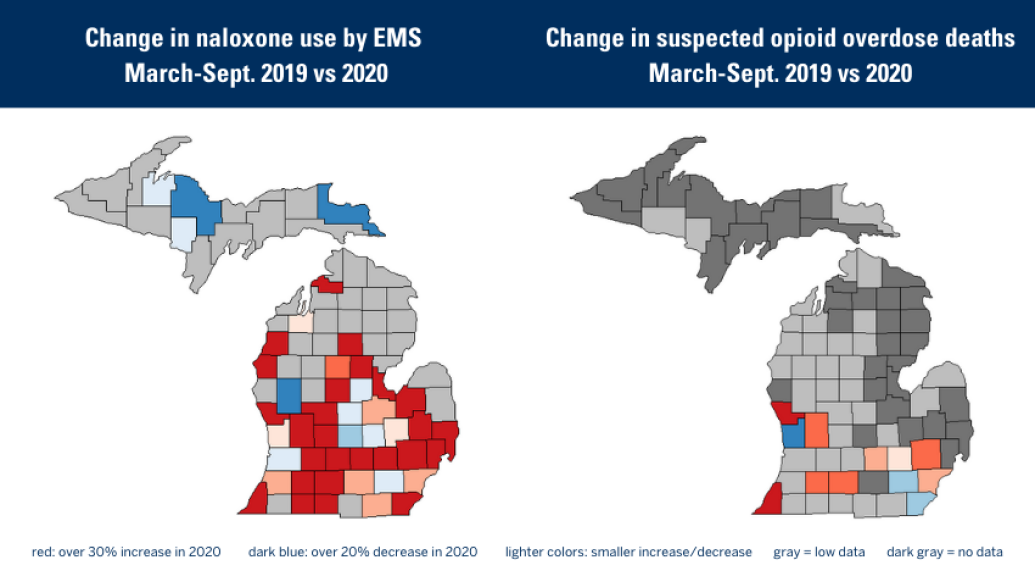Suspected overdose deaths and naloxone rescue attempts by EMS up sharply in Michigan compared with 2019; first responders and public health agencies hail new system for timely data.
10:16 PM
Author |

COVID-19 may dominate the headlines. But another epidemic that was already raging before it arrived has flared up in recent months, too, according to new University of Michigan data.
A real-time tracking system that launched in 2019 shows a 15% rise in suspected opioid overdose deaths across most of Michigan since March, compared with the same time last year, and a 29% rise in first responders' use of a rescue drug called naloxone that can reverse an opioid overdose if given in time. The deaths started rising soon after the pandemic arrived in Michigan, while naloxone use dipped before rising to new heights later in the spring and summer.
SEE ALSO: Keeping Our Patients Safe During COVID-19
The system, run by the University of Michigan Injury Prevention Center and created in partnership with the Michigan HIDTA, a federal program that tracks drug trafficking, gathers data from EMS agencies and medical examiners across most of Michigan.
Called the System for Opioid Overdose Surveillance, or SOS for short, it presents data down to an approximate location in a secure dashboard that first responders and public health authorities can use to target their opioid prevention and response efforts.
The system makes critical data available in a timely way, with daily updates from most sources. And in the time of COVID-19, it shows the two epidemics may be related.
"While we don't have a cause-and-effect explanation for what we're seeing, we know that in the first few months after the pandemic arrived in Michigan, many people were avoiding emergency departments unless they had severe symptoms of COVID-19," says the Injury Prevention Center's director Patrick Carter, M.D., an emergency medicine physician at Michigan Medicine, U-M's academic medical center.
"The increase in opioid-related fatalities during those initial months appears to fit this pattern," he continues. "The isolation and stress of the pandemic, the loss of jobs and therefore insurance that might cover substance abuse treatment, and even changes in how people have gathered during these months, may all play a role in how people are using opioids, including relapsing during recovery. Efforts to distribute naloxone and engage in peer counseling also decreased during the early months of the pandemic, as public health agencies focused on the virus."
Higher peaks in opioid overdose deaths, especially in COVID-19 peak counties
A week-by-week graph of fatal overdoses suspected of being caused by opioids of all kinds shows rates in counties with data coverage were already higher in the early weeks of 2020. Between 30 and 40 Michiganders died of a suspected opioid overdose each week.
But when the coronavirus surge began in mid-March, that number topped 40 a week, and kept rising through early June. It didn't fall back to the level seen in early 2020 until late August. While 2019 also saw a rise in the warmer months of the year, the average number peaked around 40 a week that year.
SEE ALSO: This Drug Could Save Their Lives, But Less Than 2% Get It
Similarly, the use of naloxone by emergency medical responders to try to rescue a person suffering an overdose started the year at around 250 a week. But it started rising steadily in mid-March and crested in early August at nearly 400 a week on average. In 2019, the warmer months also showed a rise – but the number of naloxone uses peaked at around 275 a week on average.
A county-level map shows that from March to mid-September, the counties hit hardest by COVID-19 during the spring surge also had the largest relative increases in overdose deaths. But naloxone administrations were up across most of the southern and middle Lower Peninsula, while they dropped in the Upper Peninsula.
A system built for real-time response to drug trafficking
The surveillance system was created by the Injury Prevention Center using its funding from the Centers for Disease Control and Prevention, and building on its partnership with the Michigan High Intensity Drug Trafficking Area organization run by the United States Office on National Drug Control Policy.
Jason Goldstick, Ph.D., is the project's principal investigator and director, and a research associate professor in the department of emergency medicine.
The HIDTA focuses on tracking and targeting drug trafficking in twelve counties of southeast and southwest Michigan, and the surveillance system by the Prevention Center can assist law enforcement in spotting areas where drug trafficking is high. It pulls data from two existing sources – the Michigan EMS Information System (MI-EMSIS) and the Medicolegal Death Investigation Log (MDILog) used by most medical examiners; additional data comes from individual county medical examiners.
SEE ALSO: Seeking Medical Care During COVID-19
The System for Opioid Overdose Surveillance offers a public dashboard showing county-level data and a state-level trend for the current year. For first responders and public health agencies, it offers a password-protected dashboard with details down to the approximate point level, though locations are randomly displaced to protect individual privacy.
Since first responders often give naloxone to nonresponsive people at scenes to which they're called, not all of the naloxone administrations seen in the system are certain to be for opioid overdoses. But on the flip side, not all naloxone doses are reported or shared in real time.
The system also gives demographic data and summaries based on time and place about those who have been given naloxone or died of a suspected overdose – data that public health officials have used to target specific groups of people in an area so they have naloxone kits handy and don't have to wait for first responders.
Voices of System for Opioid Overdose Surveillance users
In Genesee County, the Metro Police Authority that covers Mundy Township and the City of Swartz Creek provided an endorsement of the surveillance system, saying "the timeliness of the information within the dashboard is very useful to us for early detection of opioid use trends to which we can begin to appropriate resources for enforcement and mitigation."
In Detroit, a mobile naloxone distribution unit run by the Detroit Health Department has used the surveillance system's data to guide its outreach.
"The System for Opioid Overdose Surveillance team was intentional about engaging Detroit community-based organizations in the design of the platform; to me, this demonstrates their belief in the practice of data justice, because they sought to understand the lived experiences, barriers and assets of the communities being studied, in order to create a tool that is responsive to residents and neighborhood organizations leading action to address the opioid crisis," says Adaora Ezike, MHS, the trauma & behavioral health manager in the Detroit health department's behavioral health division.
Like Podcasts? Add the Michigan Medicine News Break on iTunes or anywhere you listen to podcasts.
"We also utilize demographic data from these system for opioid overdose surveillance reports to develop and vet culturally-informed overdose prevention messaging for our public education campaign," she adds.
Peer recovery coaches, who have experienced drug dependence themselves and are now dedicating themselves to helping others get help for their drug issues, have also used the system's information.
Next steps for overdose tracking, during a pandemic and after
The team has received additional funding from the federal Substance Abuse and Mental Health Services Administration and the CDC to help more agencies contribute data to the dashboard, and use it in their work.
The team is also preparing to share a "how to" kit in the form of a journal article describing how they created the system, in hopes that other states or regions could copy the approach.
Michigan's dashboard is believed to be the first in the country to include both real-time naloxone administration and suspected overdose death data, without additional action needed by the agencies beyond their usual reporting. Other systems, like one called ODMAP, are not built on passive surveillance like this surveillance system is. In many jurisdictions, they require active data entry by police and other first responders.
The next big effort for the surveillance system is to enhance the dashboard by adding new capabilities like spike alerts, data overlays and more customizable geographic windows. The team also hopes to engage with stakeholders on the west side of Michigan to understand their needs and potential uses of system's data.
Recent announcements from the Michigan Department of Health and Human Services, based in part on a subset of hospital data, show general trends in overdoses similar to what the surveillance system shows.
"The more we can help agencies micro-target and prioritize their efforts during the pandemic, when it's harder to get resources to people and public health agencies are stretched, the better," says Carter, who is also a member of the U-M Institute for Healthcare Policy and Innovation.

Explore a variety of health care news & stories by visiting the Health Lab home page for more articles.

Department of Communication at Michigan Medicine
Want top health & research news weekly? Sign up for Health Lab’s newsletters today!





